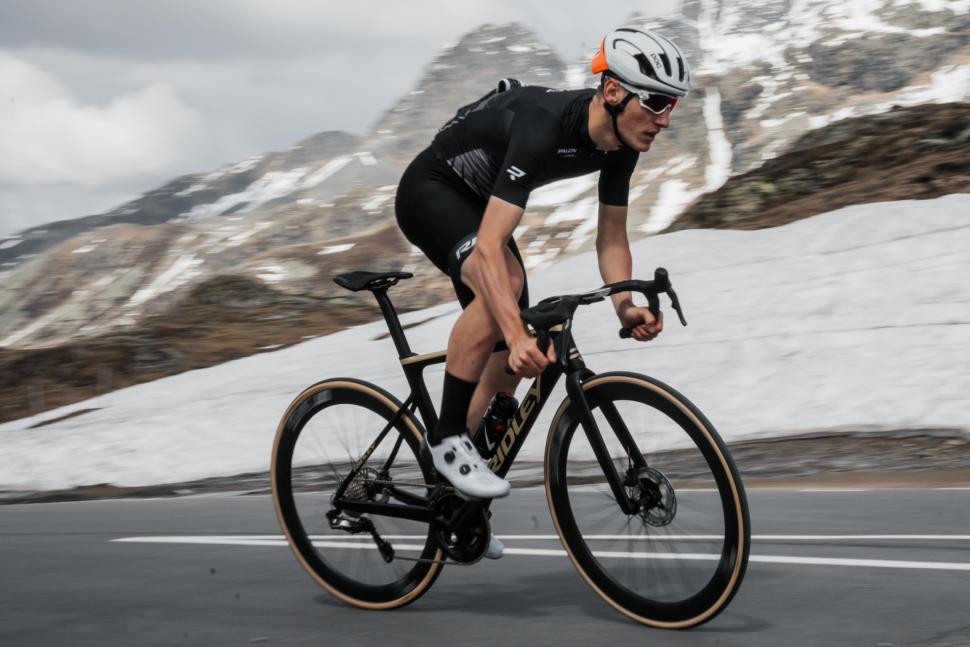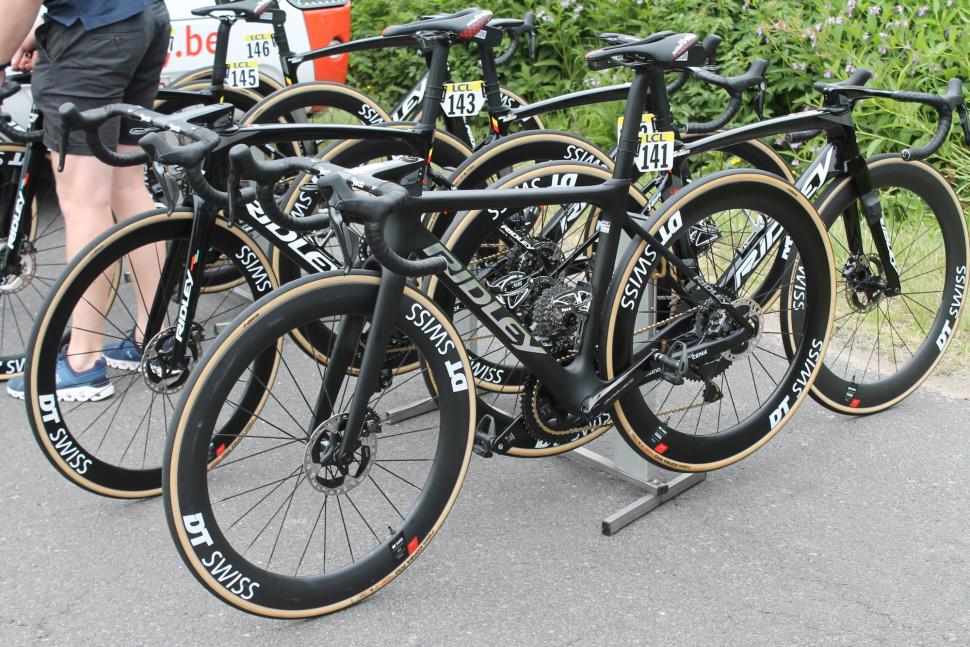- News
- Reviews
- Bikes
- Components
- Bar tape & grips
- Bottom brackets
- Brake & gear cables
- Brake & STI levers
- Brake pads & spares
- Brakes
- Cassettes & freewheels
- Chains
- Chainsets & chainrings
- Derailleurs - front
- Derailleurs - rear
- Forks
- Gear levers & shifters
- Groupsets
- Handlebars & extensions
- Headsets
- Hubs
- Inner tubes
- Pedals
- Quick releases & skewers
- Saddles
- Seatposts
- Stems
- Wheels
- Tyres
- Tubeless valves
- Accessories
- Accessories - misc
- Computer mounts
- Bags
- Bar ends
- Bike bags & cases
- Bottle cages
- Bottles
- Cameras
- Car racks
- Child seats
- Computers
- Glasses
- GPS units
- Helmets
- Lights - front
- Lights - rear
- Lights - sets
- Locks
- Mirrors
- Mudguards
- Racks
- Pumps & CO2 inflators
- Puncture kits
- Reflectives
- Smart watches
- Stands and racks
- Trailers
- Clothing
- Health, fitness and nutrition
- Tools and workshop
- Miscellaneous
- Buyers Guides
- Features
- Forum
- Recommends
- Podcast
TECH NEWS
 2023 Ridley Falcn RS - 1
2023 Ridley Falcn RS - 1Ridley combines light weight and aerodynamics on new Falcn RS road bike
Ridley has unveiled its new Falcn RS road bike which is designed to combine light weight with aerodynamic efficiency. The Belgian brand says the Falcn RS is similar to its Noah Fast Disc aero road bike in terms of drag at a weight that’s comparable with that of its Helium SLX Disc climbing machine, and describes it as “the ultimate all-round performance road bike”.
We've had the bike here at road.cc for a few weeks. Once you've got all the tech details here, head over to our review to find out how it rides.
> Check out our Ridley Falcn RS review
This is the design that we first saw raced by Lotto Dstny’s Maxim Van Gils at the Critérium du Dauphiné back in June and it’s Ridley’s entry into the ‘one bike to rule them all’ genre.
> New Ridley road bike breaks cover at Critérium du Dauphiné
Many companies have offered separate aero road bikes and lightweight road bikes over recent years, although Specialized re-introduced the idea of a single model for all situations (something that brands like Pinarello never veered from in the first place) with the launch of the Tarmac SL7 in 2020.
> One bike to rule them all: why lightweight aero bikes are now THE essential race weapon
Ridley says, “Cyclists will never have to choose between lightweight and aero anymore.
“The Falcn RS is the perfect companion for cyclists who are in search of a bike that’s light for climbing, aero and stiff for sprinting and stage rides. Thanks to its lightweight frame with aerodynamic features and wider tyre options, this is a fast, top-performing road bike that will exceed your expectations. The Falcn RS is ready for all kinds of racing: whatever is on the UCI calendar, the Falcn RS can handle it. From Ronde van Vlaanderen to Paris-Roubaix, a Grand Tour stage and Strade Bianche, you can ride it all with the new Ridley Falcn RS.”
Okay, not many of us are riding races at this level but you get where Ridley is coming from here. The Falcn RS is designed for everything from steep climbs to cobblestones.
Aerodynamics versus weight
As mentioned up top, Ridley says that the new Falcn RS offers a similar aero performance to its existing Noah Fast Disc and a weight that’s comparable with that of the Helium SLX Disc. To put some figures on it, Ridley claims a frame weight of 825g (size medium) and 380g for the fork. The combined frame and fork weight is just 110g heavier than the Helium SLX Disc.
Ridley says the fact that the Falcon RS is more aerodynamically efficient than the Helium SLX Disc is more than enough to offset that slightly heavier weight and make it a faster bike overall.
“Our in-house aerodynamicist did extensive research using CFD (computational fluid dynamics) analysis and wind tunnel testing to optimise the aerodynamics of the Falcn RS,” says Ridley.
“The frontal area of the Falcn RS is focused on aerodynamics, while the general frame design is developed to be as lightweight as possible while keeping the aerodynamics in mind.
“The Falcn RS has an aero tube profile where feasible without sharp edges in the frame, keeping the integration of the tubes simple. Moreover, the head tube is deeper to make the Falcn RS more aero. Every cross-section of the frame is aero-optimised with carefully chosen aerofoils. The shape of the top tube is even adjusted to enhance the bike’s stability under crosswinds.
“Additionally, [we] developed a fork crown including a diffuser. This induces turbulence in the airflow before the down tube, making it easier for the airflow to go over the down tube and increasing the pressure behind the head tube. The Ridley diffuser fork results in a bike that has 10% less drag at 50km/h (31mph) compared to the original fork. The back of the bike is made as lightweight as possible thanks to the seat tube and seatstays.”
Ridley hasn't, though, provided detailed wind tunnel data comparing the Falcn RS with bikes from other brands.
A new geometry
The Falcn RS has a new geometry that’s slightly different from that of either the Noah Fast or Helium. Ridley says that it offers “the perfect balance between speed, stability, and reactivity”.
For a start, the Falcn RS has a shorter head tube. On the medium-sized model, for example, the head tube measures 150mm. That compares with 164mm on the Noah Fast Disc and 175mm on the Helium SLX Disc.
The medium-sized Falcn RS has a 551mm stack and 397mm reach. The Helium SLX’s figures are 573mm and 390mm respectively while the Noah Fast Disc’s are 565mm and 393mm.
The idea is that this geometry puts you into a more aggressive riding position and is “particularly beneficial for riders who prioritise speed and agility”, according to Ridley.
The Falcn RS’s chainstays are slightly longer – 407mm versus 405mm – and the bottom bracket is also slightly lower. The BB drop (the position of the BB relative to a line drawn between the hubs) varies from 68mm to 75mm, depending on the frame size.
“It has been adjusted to accommodate bigger volume tyres without raising the centre of gravity,” says Ridley (more on tyre size in a sec). “This provides the rider with excellent control, especially on uneven terrain.”
The Falcn RS comes in six sizes from XXS to XL. Ridley says that the geometry of each size has been designed to maintain the same performance characteristics across the range.
Space for wide tyres
We all know that road bikes are moving towards wider tyres these days but Ridley has gone further than most in this respect. Although developed around 28mm tyres, the Falcon RS can take a width of up to 34mm.
“This allows for greater comfort and lower rolling resistance, as wider tyres can be run at lower pressures,” says Ridley.
“The wider tyre options on the Falcn RS ensure that riders can tackle rough roads with ease, without sacrificing speed or efficiency. This means that the Falcn RS can handle any road surface. Wider tyres allow riders to maintain high speeds and stay in control at all times.”
Ridley says that combined with the new geometry (above), wider tyre options make the Falcn RS “a stable and responsive ride that can handle any road with ease”.
Check out the other features
The Ridley Falcn RS comes with a Forza Cirrus Pro Integrated Road handlebar/stem with a 75mm reach and a 130mm drop, and a 5° flare. Brake hoses and any gear cables are run internally through the stem section and into the frame.
“This technology is used because of its aero advantage,” says Ridley. “It also avoids potential frame damage from cable rub and prevents the cables from getting snagged in case of a crash.”
There’s nothing unusual about internal cabling, of course. It’s found on the vast majority of road bikes at this level.
The Falcn RS features two water bottle mounts on the seat tube and three on the down tube, the idea being that you can choose between easier accessibility and improved aerodynamics.
The bike is equipped with a Universal Derailleur Hanger (UDH) at the rear and a removable front derailleur hanger. A cover replaces this hanger if you go for a 1x (single chainring) setup where no front derailleur is required.
Models and prices
Ridley Falcn RS SRAM Force AXS, £8,199
Groupset SRAM Force AXS
Wheels DT Swiss ARC 1400 50mm
Ridley Falcn RS Shimano Ultegra Di2, £8,199
Groupset Shimano Ultegra Di2
Wheels DT Swiss ARC 1400 50mm
Ridley Falcn RS Shimano 105 Di2, £6,399
Groupset Shimano 105 Di2
Wheels Forza Levanto DB, tubeless ready
The Falcn RS is also customisable via Ridley’s online configurator. You can choose the colours and pick the groupset, wheels, components, and accessories.
Mat has been in cycling media since 1996, on titles including BikeRadar, Total Bike, Total Mountain Bike, What Mountain Bike and Mountain Biking UK, and he has been editor of 220 Triathlon and Cycling Plus. Mat has been road.cc technical editor for over a decade, testing bikes, fettling the latest kit, and trying out the most up-to-the-minute clothing. He has won his category in Ironman UK 70.3 and finished on the podium in both marathons he has run. Mat is a Cambridge graduate who did a post-grad in magazine journalism, and he is a winner of the Cycling Media Award for Specialist Online Writer. Now over 50, he's riding road and gravel bikes most days for fun and fitness rather than training for competitions.



















































They are buses, not trains. They don't travel at 186mph or take over 2 miles to stop under braking. It should be inherently no more dangerous...
I'd go for 'the sun was in my eyes' as a defence, get away with murder with that one...
I have two aero bikes- an Argon18 Nitrogen and an Orro Venturi. I love the way they feel on the road. I also like the style of the deeper section...
I wonder if you could use a Northwave shoe (w/Speedplay drilling) on the Ekoi pedal. Possibly using one Look pattern cleat hole and two Speedplay...
They have here: results at 14.40. The aero bike was roughly fifteen seconds faster than a climbing bike on a descent of around 6 km, so about 3km/h...
As I've also placed here the nutter Audi and white van drivers, I've decided to give those no-nonsense keep-the-country-moving BMW drivers a list...
100% this. Policing mentality is formed by social 'norms', and the cyclist witchhunting across social media is the UK norm. Close passing a person...
That's a clear 2 points awarded there, but I guess as there's now a 25% tariff you'll only get 1.5
Fawkes Cycles is only local if you live near Oldham. That's nearly 300 miles away from me. Also, any retailer that doesn't participate in an...
Openreach under fire over delays to Amesbury cabinet repairs...